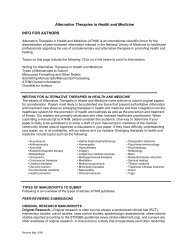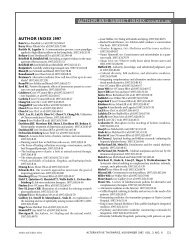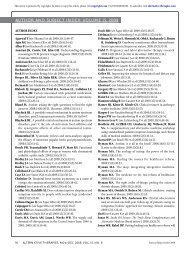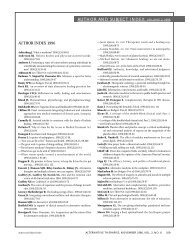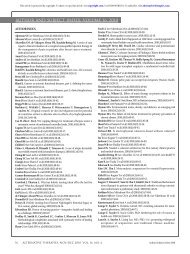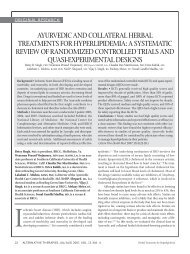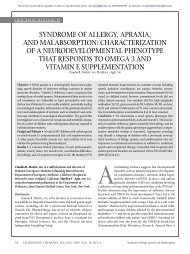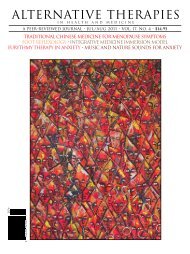Alternative Therapies In Health And Medicine
Alternative Therapies In Health And Medicine
Alternative Therapies In Health And Medicine
Create successful ePaper yourself
Turn your PDF publications into a flip-book with our unique Google optimized e-Paper software.
TABLE 4 Participant Baseline Demographics (n = 63)<br />
Highest Level of Education<br />
Grade school 1 (1.6%)<br />
High school 3 (6.3%)<br />
Undergraduate 23 (36.5%)<br />
Graduate 22 (34.9%)<br />
Postgraduate 14 (22.2%)<br />
Gender<br />
Male 33 (52.4%)<br />
Female 30 (47.6%)<br />
Ethnicity<br />
White non-Latino 62 (98.4%)<br />
Other 1 (1.6%)<br />
Age, y<br />
60 39 (61.9%)<br />
Marital status<br />
Single 5 (7.9%)<br />
Married 55 (87.3%)<br />
Widowed 3 (4.8%)<br />
Annual household income<br />
$20 001-$50 000 2 (3.5%)<br />
$50 001-$100 000 7 (12.3%)<br />
>$100 000 48 (84.2%)<br />
Work status<br />
Employed full-time 18 (28.6%)<br />
Employed part-time 3 (4.8%)<br />
Unemployed 1 (1.6%)<br />
Retired 40 (63.5%)<br />
Other 1 (1.6%)<br />
<strong>Health</strong> status<br />
Metabolic syndrome* 21 (33.3%)<br />
*<strong>In</strong>ternational Diabetes Federation criteria for metabolic syndrome.<br />
activation (PAM) in completers was not significantly correlated<br />
with change in risk of stroke (bivariate r = 0.09), diabetes (bivariate<br />
r = 0.20), and CHD (bivariate r = –0.12).<br />
Analyses also demonstrated highly significant (P < .001)<br />
improvements in the median frequency of aerobic exercise and<br />
readiness to change (RTC) for stress reduction and mental focus.<br />
Strengthening exercise and exercise stage of change remained<br />
unchanged, although all other behavioral measures also improved<br />
significantly (P < .05) (Table 7). Finally, measures of intervention<br />
integrity, including WHQ health performance and satisfaction<br />
increased significantly (P < .001), as shown in Tables 6 and 7.<br />
DISCUSSION<br />
To our knowledge, this is the first study to evaluate an integrative<br />
health model that combines an intensive 3-day health immersion<br />
and personalized health plan with follow-up education and<br />
physician and coaching support. <strong>In</strong>tegrative medicine builds upon<br />
concepts of self-determination theory and emphasizes the individual’s<br />
role in health. 53 For a patient-centered program, one of the key<br />
objectives of the current intervention was to help individuals<br />
establish health and wellness goals that were based upon their own<br />
personal values. A second and equally important objective was to<br />
partner with patients in achieving self-stated goals.<br />
Our findings indicate that although cardiac risk remained<br />
unchanged, modifiable risk factors for diabetes and stroke<br />
decreased significantly across the intervention. While the magnitude<br />
of change may appear less than significant from an epidemiological<br />
standpoint, it is notable that participants demonstrated<br />
improvements in spite of floor effects commonly observed<br />
among relatively healthy populations. <strong>In</strong> addition, multiple psychosocial<br />
and behavioral measures improved and participants<br />
became more activated towards self-management of health.<br />
Significant improvements in patient activation indicate that participants<br />
became more confident in making and maintaining<br />
healthy lifestyle changes. Importantly, baseline activation did not<br />
mediate the changes in modifiable risk. Rather, the intervention<br />
itself appears to have activated patients to change lifestyle behavior<br />
and reduce risk.<br />
The mean BMI of participants at baseline was near the normal<br />
range at 26.8, so many patients sought to maintain an already<br />
healthy weight rather than include weight loss among their health<br />
goals. Maintenance of a healthy weight represents a clinically relevant<br />
outcome in and of itself since body mass tends to increase<br />
through the sixth decade of life and such increases are related to<br />
high absolute risk of disease and mortaility. 54 Participants lost 0.9<br />
kg (approximately 2 lbs; mean = 80.5, SD = 21.3 to mean = 79.6 SD<br />
= 21; P = .01) across the intervention; however, even moderate<br />
weight loss has been associated with improvements in risk factors<br />
for cardiovascular disease and diabetes. 55-57 Furthermore, each<br />
kilogram of weight loss is on average associated with a decrease in<br />
incidence of diabetes by 16% 58 and a reduction in systolic blood<br />
pressure of 1.0 to 2.4 mm Hg. 59<br />
While short-term improvements in KYN disease risk measures<br />
may appear modest, the KYN model did not account for<br />
the potential long-term benefits that can result from reduced<br />
anger, anxiety, and depression and increased social support.<br />
Such psychosocial and quality of life measures have shown utility<br />
in predicting future health status and mortality. 60,61 High levels of<br />
anger, anxiety, and depression have been associated with risk of<br />
cardiovascular disease 62 and stroke. 63 Hence, the reduction in<br />
anger, anxiety, and depression and improvement in WHQ satisfaction<br />
and performance may represent long-term benefits not<br />
captured by the KYN disease risk model.<br />
Disease Risk Improves With <strong>In</strong>tegrative Immersion Model<br />
ALTERNATIVE THERAPIES, jul/aug 2011, VOL. 17, NO. 4 43



